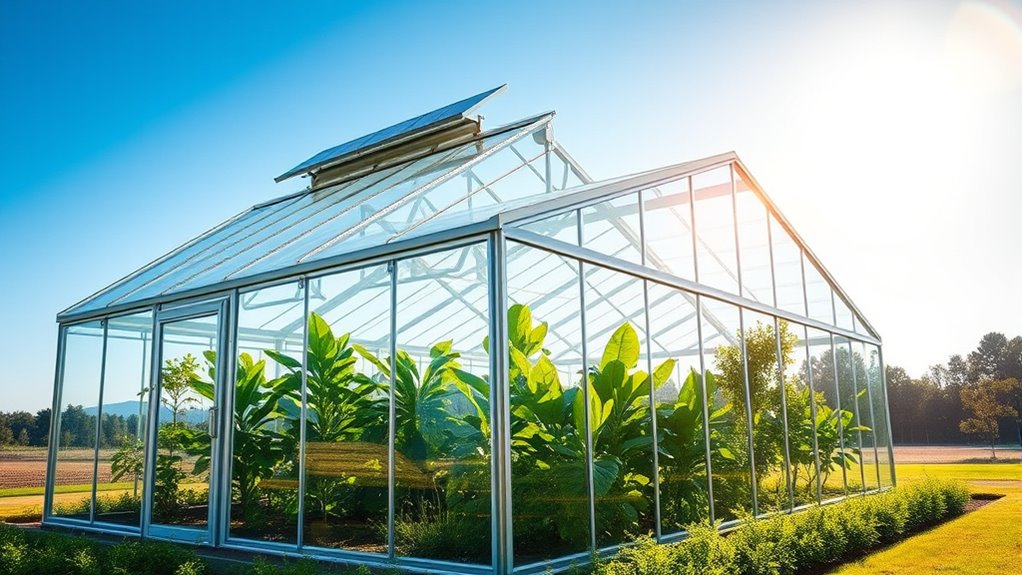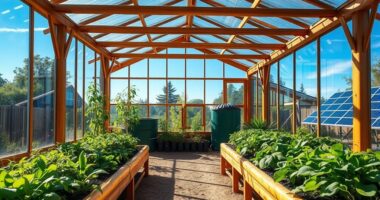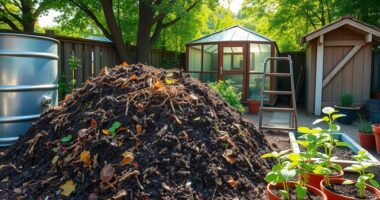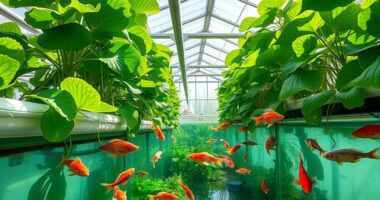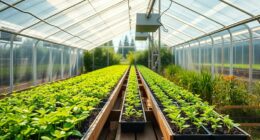Solar-powered greenhouses use renewable energy to create sustainable growing environments year-round, reducing reliance on fossil fuels. High-efficiency solar panels maximize electricity generation even in limited spaces or less direct sunlight, powering heating, lighting, and ventilation systems. Good insulation helps maintain consistent internal temperatures, cutting down energy costs and supporting healthy plant growth. Combining advanced solar technology and insulation creates a green, eco-friendly space that’s cost-effective and efficient—if you keep exploring, you’ll discover how these innovations work together seamlessly.
Key Takeaways
- Solar-powered greenhouses utilize renewable energy to sustainably support plant growth and reduce fossil fuel dependence.
- High-efficiency solar panels maximize energy capture, powering heating, lighting, and ventilation systems effectively.
- Proper insulation minimizes heat loss, maintaining stable internal temperatures and reducing energy consumption.
- Combining efficient solar panels with good insulation enhances overall system performance and lowers operational costs.
- These greenhouses promote environmentally responsible agriculture by integrating renewable energy with advanced climate control technology.

Solar-powered greenhouses are transforming the way we grow plants by harnessing renewable energy to create sustainable environments. When you install solar panels on your greenhouse, you’re tapping into an eco-friendly power source that reduces reliance on fossil fuels. But not all solar panels are created equal. Solar panel efficiency plays a pivotal role in determining how much sunlight your panels can convert into usable electricity. Higher-efficiency panels capture more sunlight, allowing you to generate ample energy even with limited space or less direct sunlight. This means you can power heating, lighting, and ventilation systems more effectively, guaranteeing your plants thrive year-round. As technology advances, more efficient panels become affordable, making solar-powered greenhouses increasingly practical for both hobby growers and commercial operations.
Solar-powered greenhouses use efficient panels to maximize energy and support sustainable plant growth year-round.
Alongside choosing the right solar panels, paying attention to greenhouse insulation is equally essential. Proper insulation minimizes heat loss during colder months and keeps the environment stable, reducing the energy needed for heating. When you insulate your greenhouse well, it requires less energy to maintain ideal temperatures, making your solar power system more efficient and cost-effective. Insulation materials like double-glazed glass, polycarbonate panels, or foam board can help trap warmth inside while preventing cold drafts. Sealing gaps around doors, vents, and windows further enhances insulation, ensuring that the energy generated by your solar panels isn’t wasted fighting against external temperature swings. With good insulation, you extend the benefits of solar power, lowering your energy bills and creating a controlled environment that promotes healthy plant growth.
Combining high solar panel efficiency with excellent greenhouse insulation allows you to maximize the benefits of renewable energy. It’s not just about installing solar panels but creating a holistic system that leverages technology and design to reduce your carbon footprint and operating costs. When your solar panels produce more electricity, and your greenhouse retains heat more effectively, you’re setting up a sustainable cycle where energy use is optimized, and environmental impact is minimized. You’ll find that investing in quality insulation and efficient solar panels pays off by providing a stable climate inside your greenhouse, regardless of external weather conditions.
Ultimately, your goal is to create an energy-smart environment where solar power supports all your plant-growing needs. By paying close attention to solar panel efficiency and greenhouse insulation, you’ll ensure your greenhouse remains productive and environmentally friendly. This approach not only makes economic sense but also aligns with the broader movement towards sustainable agriculture and responsible resource use. With thoughtful planning and the right technology, your solar-powered greenhouse can become a model of efficiency, innovation, and environmental stewardship. A key factor is selecting solar panel efficiency, which directly influences how well your system performs and how much energy you can generate.
Frequently Asked Questions
What Is the Initial Cost of Installing Solar-Powered Greenhouses?
You’ll find that the initial investment for installing solar-powered greenhouses varies based on size and technology, but generally, it can range from $10,000 to $50,000 or more. This upfront cost covers solar panels, installation, and system integration. While it may seem high initially, evaluating the financial feasibility shows long-term savings on energy costs. Your investment can pay off through reduced operating expenses and environmental benefits.
How Much Energy Can a Solar-Powered Greenhouse Generate Annually?
You can generate a significant amount of energy annually with a solar-powered greenhouse, depending on solar panel efficiency and climate conditions. Typically, a well-designed system produces enough power to meet most greenhouse needs, and surplus energy can be stored for cloudy days. Efficient solar panels maximize energy capture, while effective greenhouse energy storage guarantees a steady power supply, helping you reduce reliance on external energy sources and lower operational costs.
Are Solar-Powered Greenhouses Suitable for All Climate Zones?
Did you know that solar-powered greenhouses can be effective in over 80% of climate zones? You might wonder if they’re suitable for your region. Climate adaptability varies, but with proper design and technology, they can work in diverse environments. Regional suitability depends on local sunlight, temperatures, and insulation. So, while not perfect everywhere, solar greenhouses offer flexible solutions for many climates, making them a viable choice for sustainable agriculture.
What Maintenance Is Required for Solar Panels in Greenhouses?
You need to regularly maintain your solar panels in greenhouses by performing panel cleaning to remove dust, dirt, and debris that can reduce efficiency. Additionally, you should check the inverter periodically to verify it’s functioning properly. Keeping panels clean and in good working order helps maximize energy production, so schedule these maintenance tasks regularly to keep your solar system running smoothly and efficiently.
Can Solar-Powered Greenhouses Be Integrated With Other Renewable Energy Systems?
Think of your greenhouse as a symphony, where different renewable energies play in harmony. You can definitely integrate solar power with other systems like wind or geothermal, creating a hybrid energy setup. This system integration boosts efficiency and guarantees a steady supply of renewable energy. By combining these sources, you optimize your greenhouse’s sustainability, much like a well-conducted orchestra, ensuring healthy plant growth and a greener future.
Conclusion
By choosing solar-powered greenhouses, you harness renewable energy to grow sustainably while reducing your carbon footprint. Some might worry about initial costs, but the long-term savings on energy and maintenance outweigh the investment. Embracing this eco-friendly approach not only benefits the environment but also boosts your resilience against fluctuating energy prices. So, don’t let concerns hold you back—solar greenhouses offer a smart, forward-thinking way to cultivate a greener future.
